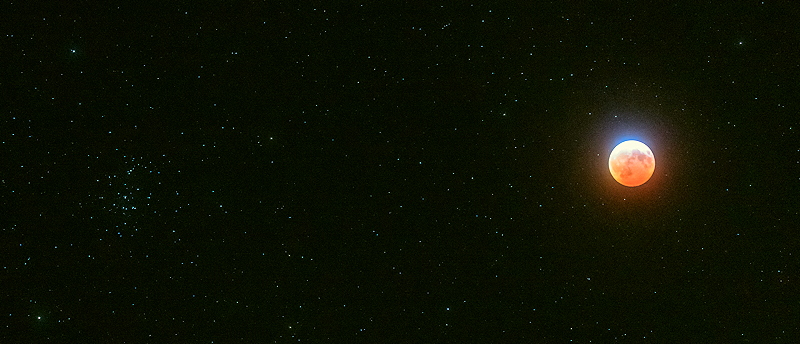Cloudy Total Lunar Eclipse
Posted: 21 January 2019
As forecast, the sky was cloudy in Oracle for the Total Lunar Eclipse on Sunday night, 20 January 2019. This was the view to the west shortly after sunset:

I did not open the observatory.
Equipment Used:
SkyTracker Pro (dead battery?)
Camera tripod
Camera:
D850 DSLR + 150-600mm lens
D7200 DSLR + 8mm 180° fisheye lens
A few minutes before the Partial Phase began I set up the D850 DSLR with 150-600mm lens on the SkyTracker Pro on the house back patio:

Unfortunately, the SkyTracker Pro would not track. Its LEDs came on but the motor did not run. I had charged the SkyTracker Pro on Friday, 18 January, and successfully used it that night for my Eclipse dry run. I will have to troubleshoot the problem, but obviously could not do that during the eclipse. So I had to manually track the Moon's motion during the eclipse.
I took photos of the eclipsed Moon through thin clouds at regular intervals using the D850 DSLR at a focal length of 600mm. For most of the Partial Eclipse Phase and much of the Total Eclipse Phase the Moon was mostly visible through the clouds. As the Total Phase ended the clouds finally became thick enough at the Moon that I ended photography.
This is a montage of the Eclipse showing the Moon at the start of the Partial Phase, mid-Partial, the start of the Total Phase, and at mid-eclipse:

This is the mid-eclipse photo at full-frame with some stars visible:

The eclipsed Moon was 6.5° west of the Beehive Cluster (M44, Praesepe). Although the clouds hampered the view, the cluster was faintly visible during the Total Phase. This photo was the D850 DSLR was taken at a focal length of 150mm (slightly cropped) and shows the cluster at the left with the eclipsed Moon at the right:

Although the clouds prevented my plans for all sky photography at various times during the eclipse, I did set up the D7200 DSLR with an 8mm 180° fisheye lens:

This photo was taken a few minutes before mid-eclipse and shows the sky over Oracle. The Moon is at the left, with the constellation of Orion below center, Auriga in the center, and Cassiopeia at the top right. The Pleiades and Double Cluster star clusters are also visible in the photo. The Winter Milky Way runs diagonally through the photo from the lower left to the upper right.

I was happy the cloud cover was not worse and allowed some nice viewing of this Total Lunar Eclipse.
Comments are welcome using Email. Twitter users can use the button below to tweet this report to their followers. Thanks.
Cassiopeia Observatory Home Page
Copyright ©2019 Michael L. Weasner / mweasner@me.com
URL = http://www.weasner.com/co/Reports/2019/01/21/index.html
